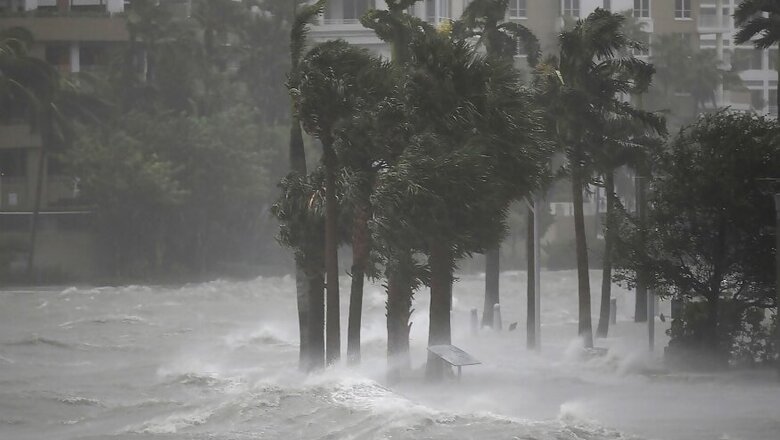
views
New Delhi: Cyclone Titli made landfall near Gopalpur in Odisha's Ganjam district early Thursday morning, accompanied with wind speeds that reached up to 126 kmph. Coastal and adjacent interior regions in Odisha received heavy rainfall and will continue to do so. Northern Andhra Pradesh has been affected too, albeit not as severely as coastal Odisha.
The high speed winds have caused damage to kuchha houses, trees and electricity poles have been uprooted, officials said. Heavy rainfall is expected to continue till Friday before dampening as the storm moves North and Northeastward. Over 3 lakh people have been evacuated and warning signals to fishermen were issued. On Wednesday, Titli was upgraded to a 'very severe cyclonic storm' category, one that would be accompanied by winds with surface speeds of up to 145 kmph.
Bay of Bengal and the Odisha coastline is no stranger to severe category cyclonic storms though. Superstorms like Phailin, Hudhud and the infamous 1999 Odisha cyclone have lashed the region in the past, taking thousands lives and uprooting countless homes.
Hudhud
Hudhud was 'extremely severe' category cyclonic storm that hit the Eastern coastline of India in October 2014. It originated from a low pressure system caused by upper-air cyclonic circulation in the Andaman sea. The storm made landfall near Visakhapatnam, Andhra Pradesh, with wind speeds reaching up to 185 kmph. The storm then turned toward North, crossing Odhisha, Uttar Pradesh before it reached Nepal. These regions received heavy rainfall, while Nepal received heavy snowfall. Hudhud triggered avalanches in Nepal and the region underwent a snowstorm disaster that lead to the deaths of at least 43 people.
In India, Andhra Pradesh was affected severely. The National Disaster Response Force (NDRF) ad made preparations for the storm's landfall and several trains along the East coast of India were cancelled. The cyclone first passed through Andaman islands gaining intensity and before it made landfall in Andhra, nine districts were already on high alert. The heavy rainfall and strong winds in coastal Andhra claimed three lives just after landfall at Visakhapatnam. A total of 61 people lost their lives in Andhra Pradesh in the cyclone.
The storm lost intensity as it moved North and entered Odisha. Balasore, Kendrapara, Bhadrak, Jagatsinghpur, Puri, Ganjam, Mayurbhanj, Jajpur, Cuttack, Khurdha, Nayagarh, Gajapati, Dhenkanal, Keonjhar, Malkangiri and Koraput districts were on high alert. Southern Odisha experienced heavy rainfall and wind speeds of about 90 kmph. The government has evacuated 67,752 people to safe places and cyclone centres in the southern districts before the storm reached Odisha.
Phailin
The most intense cyclonic storm to make landfall in India since the infamous 1999 Odhisha cyclone, Phailin was dubbed as a 'super storm'. Formed as a tropical depression in October 2013 in the Gulf of Thailand, Phailin moved westward, crossed the Andaman sea and proceeded West-Northwest. Over the Bay of Bengal, the cyclonic system was equivalent to a category 5 hurricane and it gradually weakened as it reached Odisha coast. Five years ago to the day, Phailin made landfall at Gopalpur.
The cyclone triggered India's biggest evacuation drive in 23 years as more than 550,000 people were moved from the coastal to interior and safer regions. Food and relief materials had been stocked-up at storm shelters and storm warnings had gone out in advance. Schools, colleges and businesses were shut down expecting heavy rainfall and strong winds. Trees and electricity poles were uprooted due to the windy conditions even in interior regions.
Phailin also caused flooding and damaged crops in over 500,000 hectares of agricultural land in the state. 44 people reportedly lost their lives in Odisha due to the storm.
1999 Odisha Cyclone
The 1999 cyclone was the strongest, most destructive cyclone recorded in the region. It began as a tropical depression in the Andaman sea in October 1999 and it grew in strength as it moved West-Norhtwestard. It reached super cyclonic storm intensity, with wind speeds reaching up to 260 kmph a day before it made landfall in Odisha.
It was the most severe storm to hit Odisha in the 20th century. The region received torrential rain, strong winds and high storm surge. It caused widespread flooding, with the surge carrying coastal debris, and entire towns and villages were left inundated. Most of the winter-time harvest was destroyed. The government estimated the official death toll as 9,887. The unofficial death toll was considerably higher. Thousands lost their lives in the rising storm surge. Over 8,000 deaths occurred in Jagatsinghpur alone. Government declared it a national disaster in the aftermath of the storm. 12 districts in Odisha — Balasore, Bhadrak, Cuttack, Dhenkanal, Jagatsinghpur, Jajpur, Keonjhar, Kendrapada, Khurda, Puri, Mayurbhanj, and Nayagarh — had suffered severe destruction and complete breakdown of essential services. In the aftermath, many epidemics and diseases spread through the state as well.



















Comments
0 comment